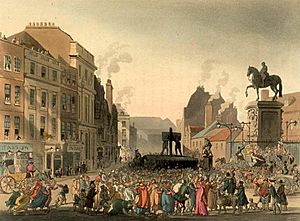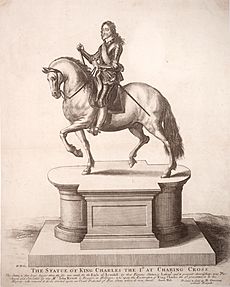As I was going by Charing Cross facts for kids
Quick facts for kids "As I was going by Charing Cross" |
|
|---|---|

Charing Cross with the statue of Charles I to the right
|
|
| Nursery rhyme | |
| Published | 1840s |
| Songwriter(s) | Traditional (Unknown) |
"As I was going by Charing Cross" is a well-known English language nursery rhyme. It's also sometimes called "As I was going to Charing Cross". This rhyme was first written down in the 1840s. However, some parts of it might be much older, coming from street songs and poems from the 1600s.
The rhyme talks about a famous statue in Charing Cross, London. This statue shows King Charles I riding a horse. The rhyme might hint at his death. It could also be a playful jab from people called Puritans. They might have been making fun of those who supported the King after he was put to death. The rhyme as we know it today wasn't fully recorded until the mid-1800s.
Lyrics
Here are the words to the modern version of the rhyme:
As I was going by Charing Cross,
I saw a black man upon a black horse;
They told me it was King Charles the First-
Oh dear, my heart was ready to burst!
This song is listed in the Roud Folk Song Index. This is a special list that keeps track of folk songs and their different versions. Its number is 20564.
Origin of the Rhyme
The rhyme is believed to be about the statue of King Charles I. He ruled England from 1625 to 1649. This statue was put up after the King's son, Charles II, became king in 1660. In 1675, it was moved to its current spot in central London, at the old Charing Cross.
The statue is made of bronze and has turned very dark over time. This is why the rhyme calls the man "black." Some people also think "black" might refer to the King's dark hair.
The rhyme might have been created by putting together older short poems. For example, people in London used to sing a street cry that went like this:
I cry my matches at Charing Cross,
Where sits a black man on a black horse.
Or sometimes it was sung as:
I cry my matches by old Charing-Cross,
Where sitteth King Charles upon a black horse.
There's also a note from the 1600s found in a old book at Oxford. It contains lines that sound a lot like part of our rhyme:
But because I cood not a vine Charlles the furste
By my toth my hart was readdy to burst
The first part of the rhyme appeared in a children's book called Pretty Tales in 1808. It was part of a different, more famous rhyme called "Ride a Cock Horse." The words were:
Ride a Cock Horse,
To Charing Cross,
To see a black man,
Upon a black horse.
The version we know today probably mixes parts of these older rhymes. It also includes a line about King Charles I's execution. A person named James Orchard Halliwell was the first to collect and print this modern version in the 1840s.


